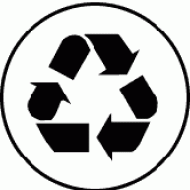Recycling Topology

It's
hard to miss the triangle of three bent arrows that signifies
recycling. It appears in newspapers and magazines and on bottles,
envelopes, cardboard cartons, and other containers.
But have you
noticed that there are two versions of this ubiquitous symbol? The
difference between them lies in the direction of the twist in one of the
three chasing arrows that make up the figure.
The late Cliff Long, who was a mathematics professor at Bowling Green State University in Ohio, had an eye for such details.
In
his mathematical studies of surfaces, Long often found it inspiring to
carve certain forms out of wood. "The carvings . . . significantly
improved [my] understanding of the surfaces . . . and the mathematics
behind them," he once remarked. His first sculpture, carved more than 30
years ago from a piece of white pine, was of a mathematical figure
known as a Mobius band.
A Mobius surface has only one side and one
edge. You can make a Mobius band by gluing together the two ends of a
long strip of paper after giving one end a half twist.
Alternative (incorrect?) rendering of the recycling symbol.
Some
time ago, Long noticed that the arrows of the usual symbol for
recycling are twisted in such a way that if they were joined together in
a continuous ribbon, they would form a Mobius band. Then, one day, he
happened upon a second version of the recycling symbol, boldly printed
in color on the front page of the Toledo Blade, that differed
from the one he had originally encountered. The new version aroused his
interest, and he carefully compared it with the one that was already
familiar to him.
Long found that the alternative recycling symbol
was based on a different surface -- a one-sided band formed by gluing
together the two ends of a long strip of paper after giving one end
three half-twists instead of just one.
Cliff Long made a Mobius band the basis of his wood carving "Bug on a Band."Photo by David Hampshire, Bowling Green State University
|
|
The
standard recycling symbol (top left) and an alternative version (top
right) can be represented by continuous folded ribbons, showing that the
standard form is a Mobius band made with one half-twist (bottom left)
and the alternative is a one-sided band with three half-twists (bottom
right).
|
If
you were to lay a string along the strip's edge until the string's ends
met and pulled the string tight, you would end up with a trefoil knot
in the string. If you did this with a standard Mobius band, you wouldn't
get a knot.
In general, all bands with an odd number of
half-twists (and their mirror images) are, roughly speaking, one-sided
surfaces. Bands with no twist or an even number of twists have two
sides. Topologists generally apply the term "Mobius band" not only to
the standard form (one half-twist) but also to the symmetric version
(three half-twists) and anything else "homeomorphic" to the standard
form.
All this made me curious about the origin of the recycling
emblem. It started with a contest sponsored by the Chicago-based
Container Corporation of America (CCA) as a special event for the
original Earth Day in 1970. Art and design students were invited to
create a symbol to represent paper recycling. The winning logo, selected
from more than 500 entries, was submitted by Gary Anderson, then an art
student at the University of Southern California.
"The figure was
designed as a Mobius strip to symbolize continuity within a finite
entity," Anderson recounted in an interview published in the May 1999
issue of the trade magazine Resource Recycling. "I used the
[logo's] arrows to give directionality to the symbol. I envisioned it
with the small edge or the point of the triangle at the bottom. I wanted
to suggest both the dynamic (things are changing) and the static (it's a
static equilibrium, a permanent kind of thing). The arrows, as broad as
they are, draw back to the static side."
Anderson's original
design was then refined by Bill Lloyd, CCA's public relations department
manager. He sharpened the lines and rotated the symbol so that the
stylized outline of a tree can be seen in its center.
Initially,
CCA licensed the design to trade associations for a nominal fee. The
company later dropped its application to register the logo as a service
mark, leaving it in the public domain. In the 1970s, the American Paper
Institute and the American Forest and Paper Association started
promoting use of this symbol to describe recyclable and recycled paper
products. Its use spread rapidly and expanded to many other items.
Long
discovered that many people are unaware that two different forms of the
recycling symbol are now actually in use. Where did the second version
come from?
Perhaps it was introduced accidentally, when someone
failed to notice that the direction of the twists in the arrows makes a
difference. One possibility is that an illustrator drew just one bent,
twisted arrow, made two copies of it, and put the arrows in a triangle
pattern, never realizing that the original symbol was meant to conform
to the shape of a standard half-twist Mobius band.
What's
fascinating about the entire recycling-symbol episode is how a geometric
shape that came out of pure mathematical research, done in the 19th
century by August Ferdinand Mobius (1790-1868), has become a modern
cultural icon.
Originally posted: 9/28/96
Updated: 4/26/03 and Thu Jul 30 09:29:20 EDT 2020